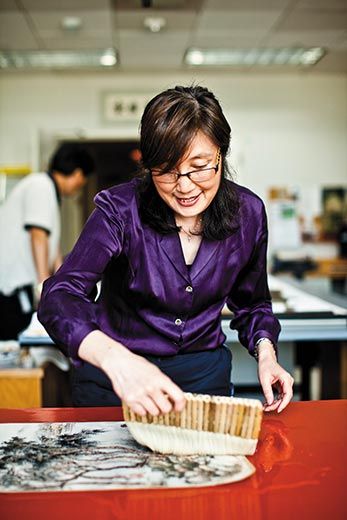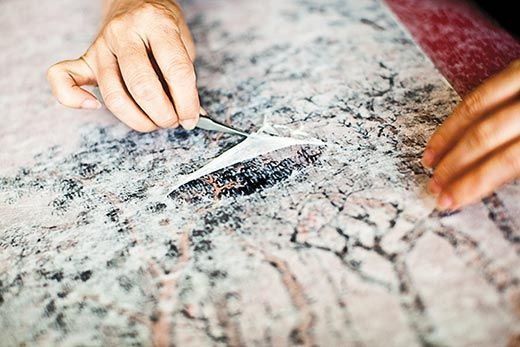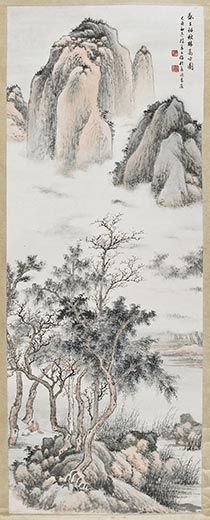Restoring Artwork to its Former Glory
With a steady hand, Xiangmei Gu wields paintbrushes and tweezers as the Smithsonian’s only conservator of Chinese paintings
/https://tf-cmsv2-smithsonianmag-media.s3.amazonaws.com/filer/Oriental-art-restoration-Xiangmei-Gu-631.jpg)
Xiangmei Gu approaches a mid-20th-century Chinese painting with a pair of pointed tweezers. Her task is to remove the last layer of deteriorated paper that backs the painting Lofty Scholar in an Autumn Grove and to replace it with fresh paper. Delicately, she punctures the sheet, then uses her fingertips to roll the brittle, yellowed fragments into small coils. Gu's staff of three seems to hold its collective breath. As the last snippet is finally removed, the relief is palpable. Later in the day, Gu—the first and only conservator of Chinese paintings at the Freer Gallery of Art and Arthur M. Sackler Gallery—will remount the painting with the help of an American assistant and two Chinese fellows.
The fellows will be staying for only three months—just enough time "to learn and review the basic techniques," Gu says. But, she adds, when it comes to art conservation, "until you stop working, you never stop learning."
Gu, 58, was in her early 20s when her own education in conservation began in 1972. After working for three years on a farm in Nanhui County, near Shanghai, she was chosen that year by the Shanghai Museum for an art scholarship—one of 30 selected from hundreds of candidates. Gu stayed at the Shanghai Museum—as student, apprentice and conservator—for 15 years.
Sitting in her studio on the main level of the Freer Gallery on the National Mall, Gu pulls a photograph from a desk drawer. In it, three students who joined the conservation department at the Shanghai Museum huddle around a teacher. Gu is the second from the left. "I was so young," she says, laughing at her appearance.
Gu came to the United States in 1987 to join her husband, Jinrui Dai, who was in graduate school at the University of Illinois at Chicago. (Today he is a retired biopharmaceutical chemist. The couple has a daughter, Sheryl Dai.) After working as a conservator at the Art Institute of Chicago, Gu wrote to the Freer's curator of Chinese paintings to ask for a job. It wasn't the usual way to apply for a position at a prestigious museum, she says with a giggle, but "because I'm from China, I don't know anything about America." In any case, it worked. Prior to her arrival at the Freer in 1990, Chinese paintings were restored by Japanese conservators, who were more accustomed to working with darker fabrics and more elaborate patterns than those found in traditional Chinese paintings.
Gu's latest project is repairing paintings for two upcoming November exhibits: "Children at Play," at the Freer, and "The Art of China," at the Sackler, which adjoins the Freer. In one 15th-century painting, A Noble Boy and His Goat, the pigment is missing and chipped, and creases mar the surface, including one that travels up the goat's belly. "Museum visitors focus on the creases and not on the art," Gu says.
She smoothes out the creases by applying thin strips of paper with paste to the painting's back and tapping them in place with a stiff brush made of palm tree fiber. Where paint is missing, she adds pigment. She sits on a small stool and mixes colors using three rows of 14 paints. When restoring darker shades, she relies on traditional Chinese pigments, which provide a thick, opaque layer; for lighter tones, she uses watercolors, which are more subtle.
Gu appears calm as she works, though she admits she sometimes gets a stomachache before undertaking a really big repair. She has never forgotten the central lesson that she learned from her teacher in Shanghai: If she makes a mistake, the painter can't come back to life to fix it.


